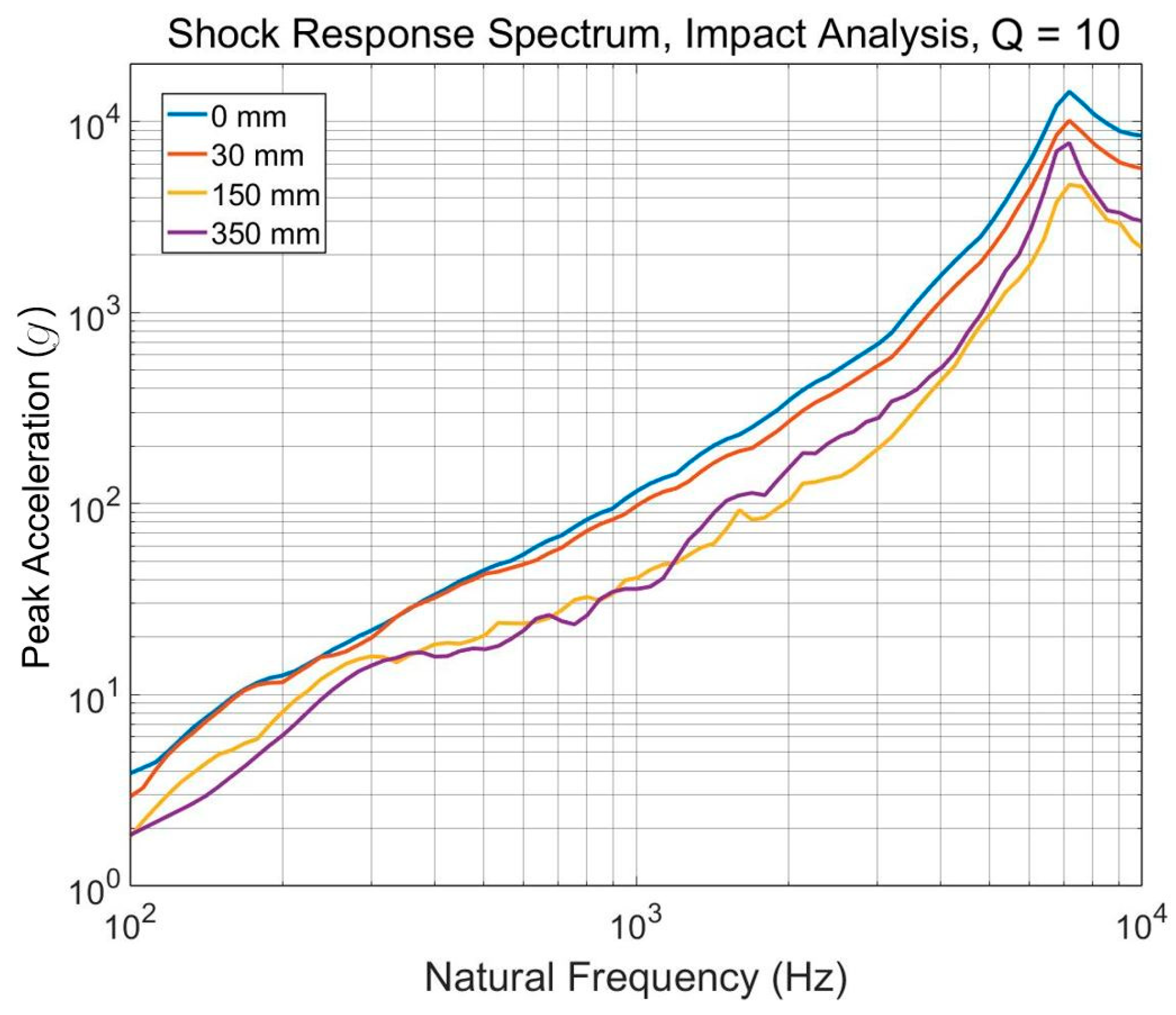Development of Impact Test Device for Pyroshock Simulation Using Impact Analysis
Abstract
:1. Introduction
2. Development of Pyroshock Simulator
2.1. Shock Environment Variables
2.2. Design of Resonator
2.3. Impact Analysis Modeling
2.4. Impact Analysis Results
2.5. Design of Launch Device
3. Evaluation of Pyroshock Simulator
3.1. Experimental Setup
3.2. Pyroshock Simulation Test
3.3. Performance of Pyroshock Simulator
4. Conclusions
Author Contributions
Funding
Conflicts of Interest
References
- Wang, X.; Liu, W.; Ding, J.; Sun, Y.; Dang, Y. Pyroshock Response Prediction of Spacecraft Structure in Wide Frequency Domain Based on Acceleration FRF. Aerospace 2022, 9, 54. [Google Scholar] [CrossRef]
- Lee, J.; Han, J.-H.; Lee, Y.; Lee, H. Separation characteristics study of ridge-cut explosive bolts. Aerosp. Sci. Technol. 2014, 39, 153–168. [Google Scholar] [CrossRef]
- Lee, J.-R.; Chia, C.C.; Kong, C.-W. Review of pyroshock wave measurement and simulation for space systems. Measurement 2012, 45, 631–642. [Google Scholar] [CrossRef]
- Lee, J.; Hwang, D.-H.; Han, J.-H. Study on pyroshock propagation through plates with joints and washers. Aerosp. Sci. Technol. 2018, 79, 441–458. [Google Scholar] [CrossRef]
- Lee, J.; Hwang, D.-H.; Jang, J.-K.; Kim, D.-J.; Lee, Y.; Lee, J.-R.; Han, J.-H. Pyroshock Prediction of Ridge-Cut Explosive Bolts Using Hydrocodes. Shock. Vib. 2016, 2016, 1218767. [Google Scholar] [CrossRef]
- Xiong, S.; Li, Y.; Ye, Y.; Wang, J.; Mu, H.; Wen, Y. Quantitatively Decoupling the Impact of Preload and Internal Mechanism Motion on Pyrotechnic Separation Shock. Int. J. Aeronaut. Space Sci. 2021, 22, 1106–1117. [Google Scholar] [CrossRef]
- Lee, J.; Kim, Y.-S.; Baek, S.-J.; Jeong, H.S. Study of Separation Mechanism and Characteristics of Ridge-Cut Explosive Bolts Using Numerical Analysis. Int. J. Aeronaut. Space Sci. 2021, 22, 84–93. [Google Scholar] [CrossRef]
- Bateman, V.I.; Davie, N.T. Pyroshock Testing. In Harris’ Shock and Vibration Handbook, 6th ed.; Piersol, A.G., Paez, T.L., Eds.; McGraw-Hill: New York, NY, USA, 2002; pp. 28.1–28.19. [Google Scholar]
- Moening, C.J. Pyrotechnic shock flight failures. In Proceedings of the 31st Annual Technical Meeting of the Institute of Environmental Sciences, Las Vegas, NV, USA, 29 April–3 May 1985. [Google Scholar]
- Department of Defense. Pyroshock; MIL-STD-810G, 517.1; Department of Defense: Arlington, VI, USA, 2008. [Google Scholar]
- Jeong, J.-W.; Lim, J.H.; Kim, K.-W.; Lee, J.-J. Development of a point pyroshock source simulator. Shock. Vib. 2017, 2017, 6834601. [Google Scholar] [CrossRef] [Green Version]
- Lee, S.-J.; Hwang, D.-H.; Han, J.-H. Development of pyroshock simulator for shock propagation test. Shock. Vib. 2018, 2018, 9753793. [Google Scholar] [CrossRef]
- Hwang, D.-H.; Park, H.-S.; Han, J.-H. Development of a miniature point source pyroshock simulator. J. Sound Vib. 2020, 481, 115438. [Google Scholar] [CrossRef]
- Ryschkewitsch, M.G. Pyroshock Test Criteria; NASA-STD-7003A; NASA: Washington, DC, USA, 2011. [Google Scholar]
- Harris, C.M.; Piersol, A.G. Introduction to the Handbook. In Harris’ Shock and Vibration Handbook, 6th ed.; Piersol, A.G., Paez, T.L., Eds.; McGraw-Hill: New York, NY, USA, 2002; p. 1.14. [Google Scholar]
- Meyers, M.A. Dynamic Behavior of Materials; John Wiley & Sons: New York, NY, USA, 1994. [Google Scholar]
- Zukas, J.A. Introduction to Hydrocodes; Elsevier: Amsterdam, The Netherlands, 2004. [Google Scholar]
- Su, Z.; Lin, Y. Identification of Damage Using Lamb Waves from Fundamentals to Applications; Springer: Berlin, Germany, 2009; pp. 15–53. [Google Scholar]
- Rohrbach, Z.J.; Buresh, T.R.; Madsen, M.J. Modeling the exit velocity of a compressed air cannon. Am. J. Phys. 2012, 80, 24–26. [Google Scholar] [CrossRef] [Green Version]






















| Parameter of Shock EOS | Unit | Aluminum Alloy 6061-T6 | Stainless Steel 304 |
|---|---|---|---|
| 2703 | 7900 | ||
| 1.97 | 1.93 | ||
| 5240 | 4570 | ||
| 1.4 | 1.49 | ||
| 295.15 | 295.15 | ||
| 885 | 423 | ||
| Parameter of Steinberg–Guinan strength model | |||
| 43 | |||
| 0.1 | 0.35 | ||
| 1.8 | 1.74 | ||
| 0.018908 | 0.007684 | ||
| 1220 | 2380 | ||
| Parameters | Value |
|---|---|
| Length of Barrel () | 800 mm |
| Inner Diameter of Barrel | 10 mm |
| Barrel Area () | 7.854 × 10−5 m2 |
| Mass of Projectile () | 3.5 g |
| Diameter of Projectile | 9.525 mm |
| Chamber Volume () | 1.059 × 10−4 m3 |
| Chamber Length | 116 mm |
| Thickness of Chamber | 10 mm |
| Inner Diameter of Chamber | 36 mm |
Publisher’s Note: MDPI stays neutral with regard to jurisdictional claims in published maps and institutional affiliations. |
© 2022 by the authors. Licensee MDPI, Basel, Switzerland. This article is an open access article distributed under the terms and conditions of the Creative Commons Attribution (CC BY) license (https://creativecommons.org/licenses/by/4.0/).
Share and Cite
Kim, B.-S.; Lee, J. Development of Impact Test Device for Pyroshock Simulation Using Impact Analysis. Aerospace 2022, 9, 407. https://doi.org/10.3390/aerospace9080407
Kim B-S, Lee J. Development of Impact Test Device for Pyroshock Simulation Using Impact Analysis. Aerospace. 2022; 9(8):407. https://doi.org/10.3390/aerospace9080407
Chicago/Turabian StyleKim, Bae-Seong, and Juho Lee. 2022. "Development of Impact Test Device for Pyroshock Simulation Using Impact Analysis" Aerospace 9, no. 8: 407. https://doi.org/10.3390/aerospace9080407






